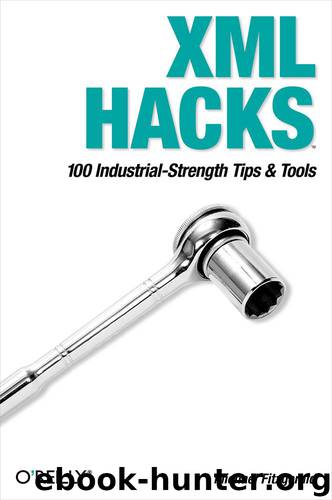XML Hacks by Fitzgerald Michael

Author:Fitzgerald, Michael [Michael Fitzgerald]
Language: eng
Format: epub
Tags: COMPUTERS / Programming Languages / XML
ISBN: 9781449397753
Publisher: O'Reilly Media
Published: 2010-10-14T16:00:00+00:00
See Also
For a more thorough introduction to SOAP, read the SOAP v1.2 primer (Part 0): http://www.w3.org/TR/soap12-part0/
SOAP v1.2 messaging framework (Part 1), including information on the SOAP processing model and message constructs: http://www.w3.org/TR/soap12-part1/
SOAP v1.2 adjuncts (Part 2), including information on the SOAP data model, encoding, and HTTP binding: http://www.w3.org/TR/soap12-part2/
Hack #64. Identify Yourself with FOAF
FOAF provides a framework for creating and publishing personal information in a machine-readable fashion. As you learn FOAF, you will also get acquainted in a practical way with RDF.
The Friend of a Friend or FOAF project (http://www.foaf-project.org/) is a community-driven effort to define an RDF vocabulary for expressing metadata about people and their interests, relationships, and activities. Founded by Dan Brickley and Libby Miller, the FOAF project is an open, community-led initiative that is tackling head-on a small and relatively manageable piece of the W3C’s wider Semantic Web goal of creating a machine-processable web of data. Achieving this goal quickly requires a network effect that will rapidly yield a mass of data. Network effects mean people. It seems a fairly safe bet that any early Semantic Web successes are going to be riding on the back of people-centric applications. Indeed, everything interesting that we might want to describe on the Semantic Web was arguably created by or involves people in some form or another. And FOAF is all about people.
FOAF facilitates the creation of the Semantic Web equivalent of the archetypal personal homepage: my name is Leigh, this is a picture of me, I’m interested in XML, and here are some links to my friends. And just like the HTML version, FOAF documents can be linked together to form a web of data, with well-defined semantics.
Being a W3C Resource Description Framework (RDF) application (http://www.w3.org/RDF/) means that FOAF can claim the usual benefits of being easily harvested and aggregated. And like all RDF vocabularies, it can be easily combined with other vocabularies, allowing the capture of a very rich set of metadata. This hack introduces the basic terms of the FOAF vocabulary, illustrating them with a number of examples. The hack concludes with a brief review of the more interesting FOAF applications and considers some other uses for the data.
Download
This site does not store any files on its server. We only index and link to content provided by other sites. Please contact the content providers to delete copyright contents if any and email us, we'll remove relevant links or contents immediately.
Grails in Action by Glen Smith Peter Ledbrook(9162)
Sass and Compass in Action by Wynn Netherland Nathan Weizenbaum Chris Eppstein Brandon Mathis(8808)
Azure Containers Explained by Wesley Haakman & Richard Hooper(7429)
Configuring Windows Server Hybrid Advanced Services Exam Ref AZ-801 by Chris Gill(7427)
Kotlin in Action by Dmitry Jemerov(7262)
Running Windows Containers on AWS by Marcio Morales(6968)
Microsoft 365 Identity and Services Exam Guide MS-100 by Aaron Guilmette(5392)
Microsoft Cybersecurity Architect Exam Ref SC-100 by Dwayne Natwick(5200)
Combating Crime on the Dark Web by Nearchos Nearchou(4973)
The Ruby Workshop by Akshat Paul Peter Philips Dániel Szabó and Cheyne Wallace(4660)
Management Strategies for the Cloud Revolution: How Cloud Computing Is Transforming Business and Why You Can't Afford to Be Left Behind by Charles Babcock(4524)
Python for Security and Networking - Third Edition by José Manuel Ortega(4228)
The Age of Surveillance Capitalism by Shoshana Zuboff(4209)
Learn Wireshark by Lisa Bock(4101)
The Ultimate Docker Container Book by Schenker Gabriel N.;(3883)
Learn Windows PowerShell in a Month of Lunches by Don Jones(3681)
DevSecOps in Practice with VMware Tanzu by Parth Pandit & Robert Hardt(3559)
Windows Ransomware Detection and Protection by Marius Sandbu(3537)
Blockchain Basics by Daniel Drescher(3495)
